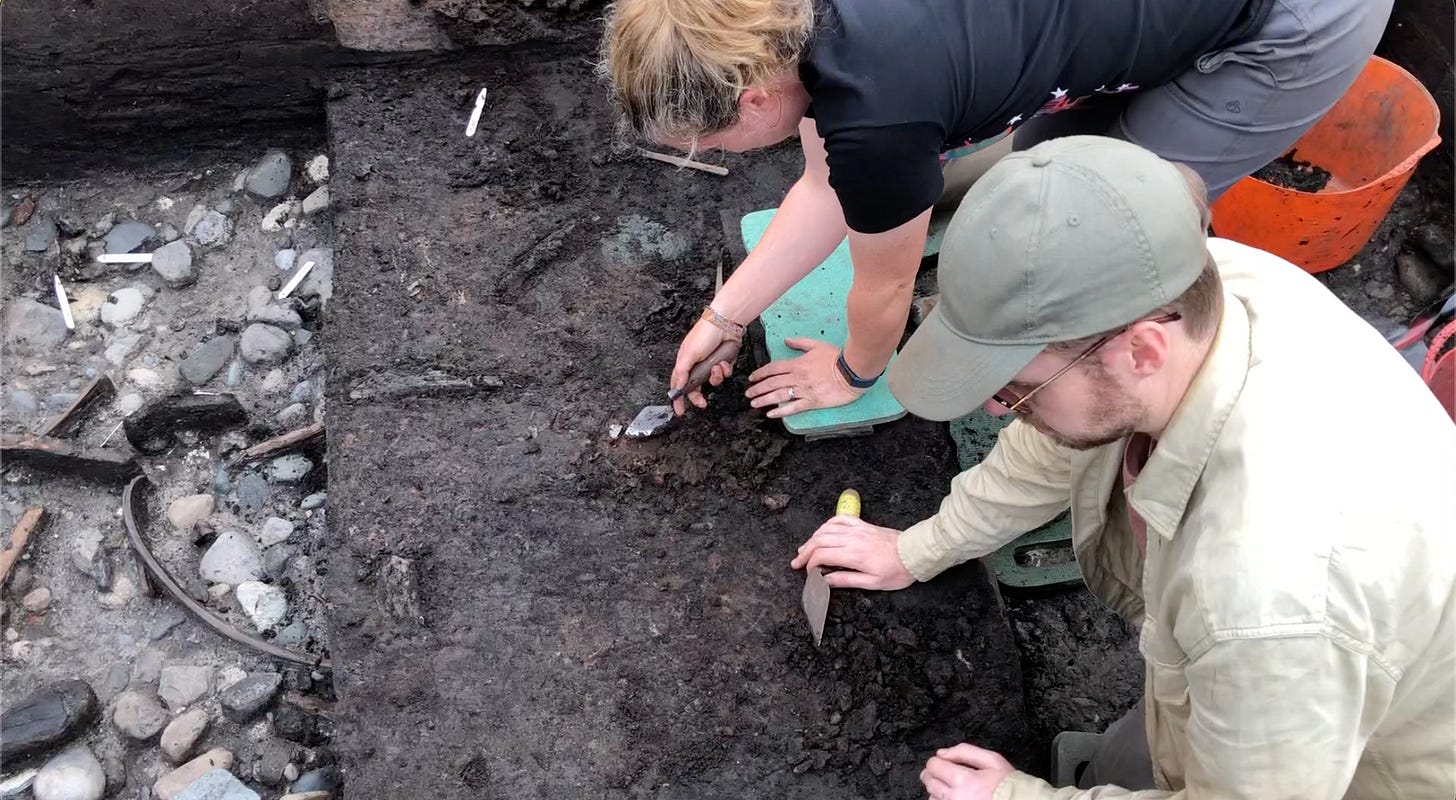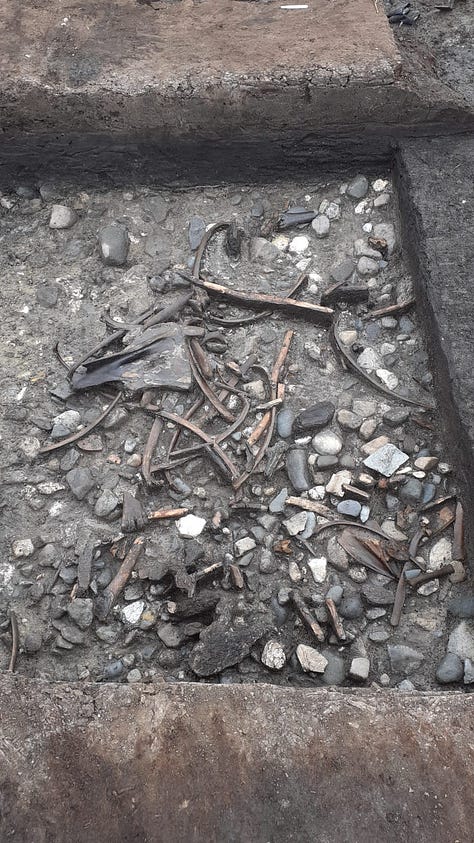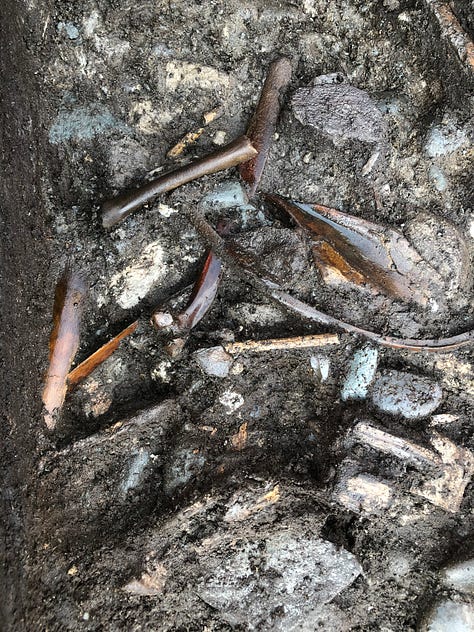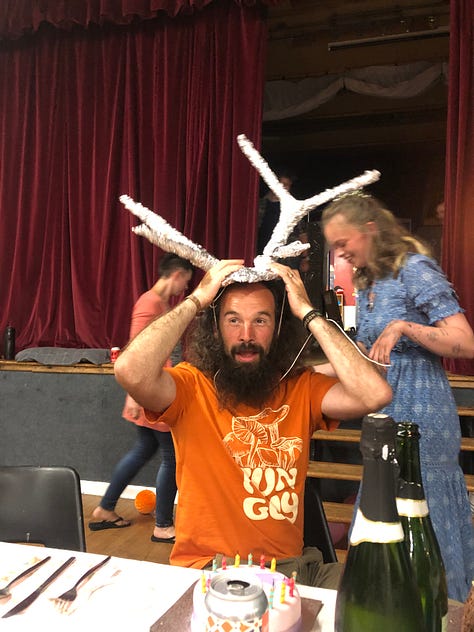Digging No Name Hill
Digging into the peaty ground of the famous Vale of Pickering
I’ll be honest here, I didn’t know what I was getting into with this dig. I didn’t grow up knowing what Star Carr was, I wasn’t entirely sure what was happening during the Mesolithic (or even when it was), and I barely knew what peat was. But midway through a folk festival, the organiser of a dig who happens to be an expert in all those things (and camping in the same zone at the festival) asked me if I wanted to come and help out. So obviously, I said yes, and drove myself from Wiltshire to Yorkshire one sunny afternoon. I hadn’t been to Yorkshire much previously, so I didn’t know what to expect, but there was definitely an audible gasp from me when I rounded a bend and saw the sun setting over the stunning Vale of Pickering - where I would be digging for the next week. The pink and yellow sky coloured the green fields in a way I’d never seen before and it made me immediately feel drawn to the place.
That was two years ago, and I now live in Yorkshire.


The Dig Site: There used to be a massive lake 11,000 years ago in Yorkshire. We call that paleo-lake, Lake Flixton. In the middle of Lake Flixton was an Island that has been lovingly dubbed ‘No Name Hill’. It is on one of the shores of No Name Hill that we were digging, first exposing layers of peat before a clay layer, and before, ultimately, the rocky lake bed. Other digs have occurred in the area but rumours have it that No Name Hill could be a site with even denser finds than Star Carr, the most famous spot along the shoreline of the Lake.
Digging Deeper: A team of academics, volunteers and students all worked on the site, digging long days marked by tea breaks and lunch time. The weather was a bit of everything, so not unusual for a dig.. but the coolest thing was the way we dug. Peat is tender, so we knelt down on wooden boards, shoulder to shoulder, digging away carefully with wooden tools as to not destroy any of the soft finds. They’ve been preserved in the oxygen free anaerobic environment of wet peat, so they look like they went in yesterday (!) however it comes at a price of extremely delicate finds.

As the tools scrape peat away, any finds are left high on plinths, so that they can be easily recorded in their location and photographed. Then they’re carefully lifted and placed in bags with water, as that’s the unique environment the finds are used to. A conservator will (later) slowly process each find, adding a water-soluble polymer then (essentially) freeze drying the find to preserve it.

Top Finds: I don’t think I could do the site any justice by listing top finds, and I honestly think that we only scratched the surface of what could be found on that site. Plenty of animal bone (including auroch bone, a massive cow-like animal that no longer exists), stone tools, barbed points and even a few *magical* headdresses. If you asked some people, the top find would’ve been the fungi that was preserved. Others would say the carved antler point. My favourite find was one I found myself (of course), which was a perfectly circular, dowel-like, long piece of wood with some tiny, sharp, microliths near. The word “arrow” was tossed around by the directors and I hope it gets analysed to confirm.



Site Digs & Dig Grub: We spent the night at the Scarborough Scout Hall, with supervisors sleeping in tents outside and students taking the bunks inside. We’d communally make large meals, drink sour beers, play card games and ninja, and every once in a while pop over to a nearby pub for a drink and (for the lads) a game of billiards. Mixed into all this could be report writing, finds organising, and it wouldn’t be too surprising to find someone working on their laptop with a pint next to them on the table. It was field school to a T!
Trowels Down: One day a week it was a day off, so trips to York or Scarborough were had — but you still had to be back ready to dig the next morning! On the final day of the dig was the ‘end of dig party’, which happened to coincide with one of the directors birthdays. As we were in a scout hall with a stage, we took things to a new level. The tables were in a U shape with candles and place settings, dinner was served, and before too long, one of the directors was on stage playing the bagpipes. We had an awards ceremony, a birthday song, and an aluminium headdress tribute. What a way to end an incredible dig! Now just waiting for grants to hopefully pull through so we can get back to site!



To Learn More: Listen to this History Hit podcast (wherever you listen!), watch the Digging for Britain episode, or see the Star Carr exhibit at the Yorkshire Museum. Oh! And if the Star Carr stuff really tickles your fancy.. the guy who found the famous Star Carr pendant? I happen to live with him, so if you have any questions, i’ll pass those along. 🤭

